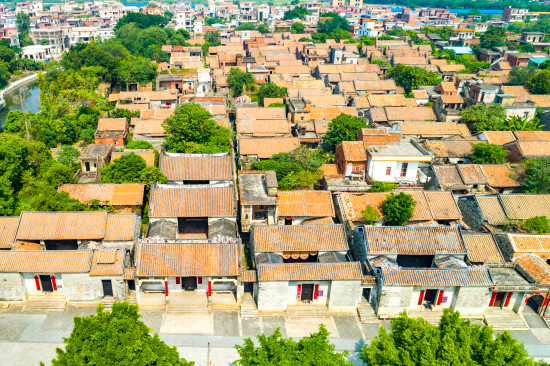As one of China’s listed historic and cultural villages, Langtou Village is a typical Guangdong village with a long tradition of self-study and farming.
Key sights in Langtou: Ancestral halls, study halls, old lanes, ancient bridge and Kapok.
Address: Langtou Village, Tanbu town, Huadu District, Guangzhou (广州市花都区炭步镇塱头村)
Tips: The village is relatively remote and tourists are suggested to drive or arrange a driver.
Self-driving route: Guangqing Expressway (Xinhua Exit)—Fengshen Dadao (in the direction of Tanbu), then go straight up after leaving the Tanbu Bridge, towards Langtou Village.

[Photo/Guangzhou Daily]
As one of China’s listed historic and cultural villages, Langtou Village is a typical Guangdong village with a long tradition of self-study and farming. Located in Guangzhou’s Huadu District, it was founded during the Yuan Dynasty (1271-1368).
Facing south, the village has a regular layout with many buildings reasonably well preserved. The entire village occupies an area of more than 60 thousand square meters.
Today, there are 388 grey brick buildings built in the Ming and Qing Dynasties, including ancestral halls, studies, academies, blockhouses and gateways. The more imposing buildings in the village are mainly ancestral halls and bookrooms. Most of them were built in the Qing dynasty (1636-1912) and a very few of them were built in the Ming Dynasty (1368-1664).
The general layout of the halls is known as the “Three Jian Three Jin” (三间三进, the space between two pillars from the front side is called one Jian and the space between two pillars from the side face is called one Jin) or “Three Jian Two Jin” (三间两进).

A collage highlighting some details of the buildings in Langtou. [Photo/Guangzhou Daily]
Diving down the myriad side streets and exploring the more ruined parts of the village offers a tantalizing glimpse into everyday life a hundred or so years ago.
The buildings have herringbone or wok ear gables to help prevent the spread of fire, and plaster carved Bogu or Dragon Boat ridges along the rooftops. Many of the halls feature high quality stone, brick, and wood carving, among which Youlan Ancestral Hall (友兰公祠) and Guyi Bookroom (谷诒书室) are perhaps the best examples.
Besides the halls and lanes, other lovely things to see are an old kapok tree and the Qingyun Bridge. The kapok tree, which is still thriving and blooming despite the ravages of more than 600 years, has become the symbol of the village. Not far from the kapok tree stands the Qingyun Bridge, a solid pink sandstone structure which was built in 1507 and has a definite mediaeval feel.










